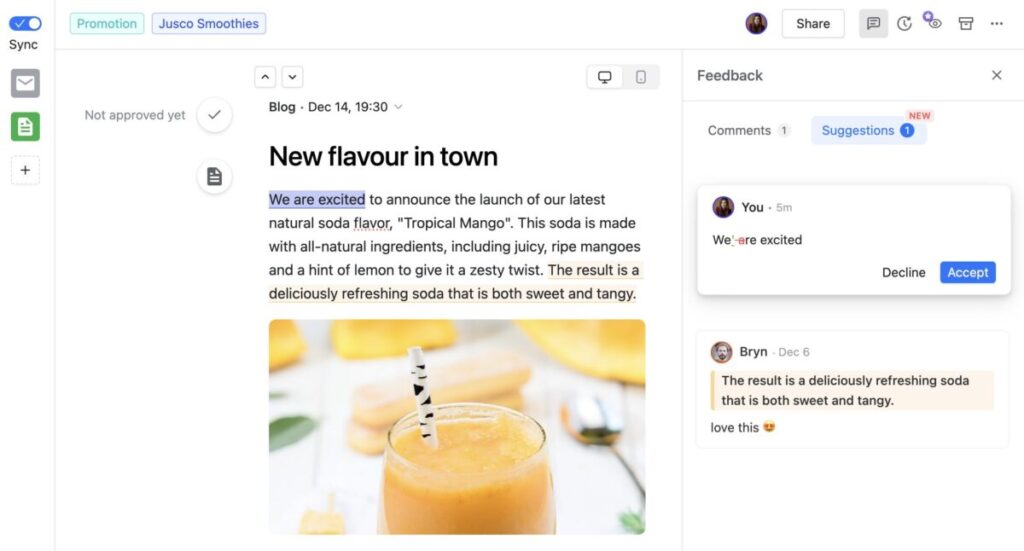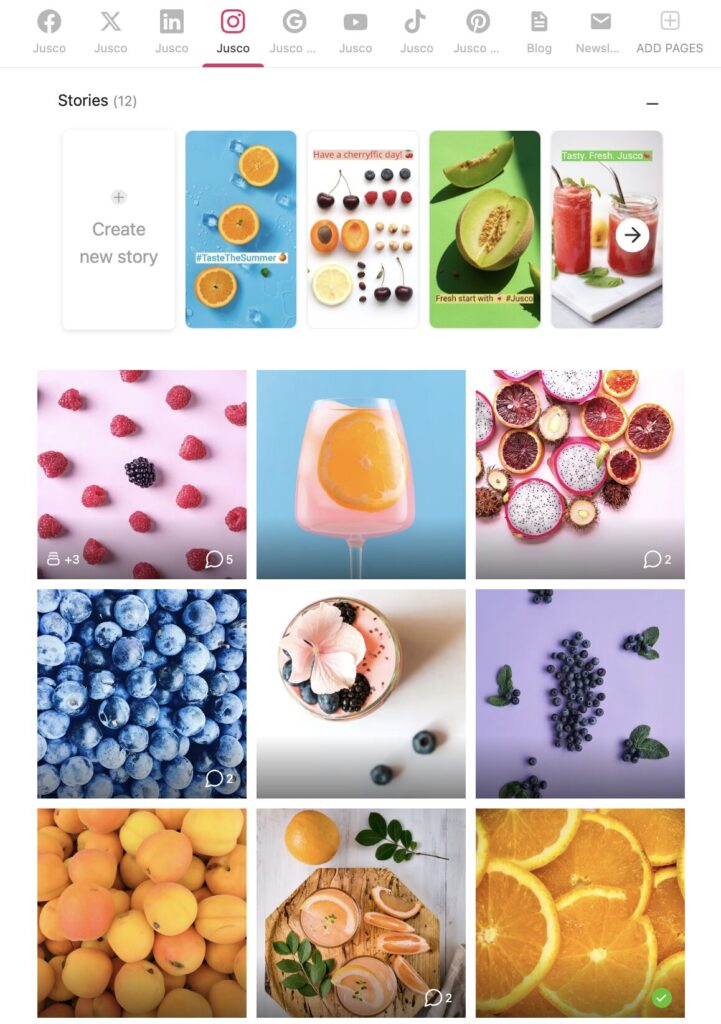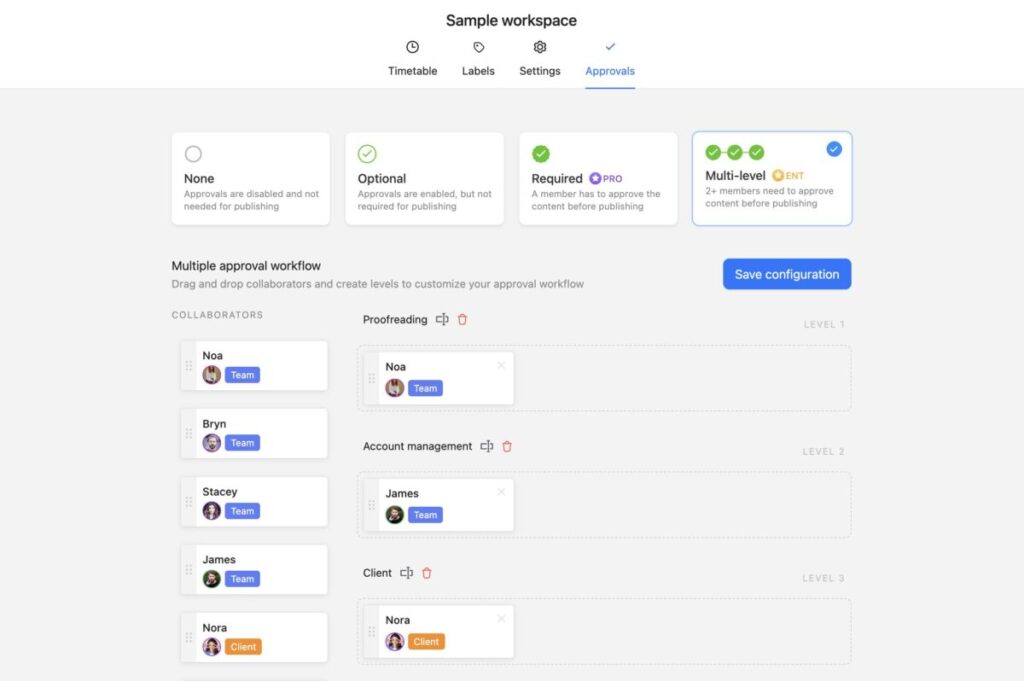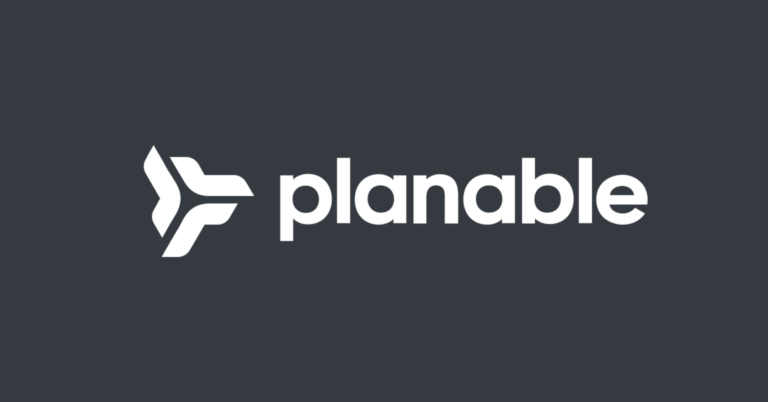As social media channels became evident as a new and vibrant advertising venue for brands, social media management software became a must-have tool in many brands' marketing stack. The appeal of these platforms was that they allowed marketers to centrally manage all their social accounts on one screen. The more social accounts there are to manage, the more appealing such solutions became for social media managers. Over a decade later, this is not the only solution marketers have to solve. While they address the problem of managing a large social presence, they don't seem to be as interested in reducing the burden on large social marketing teams.
The problem of collaboration, specifically around content creation, is what inspired the founding of Planable. While most platforms have calendars and approval tools for content, their approaches are quite limited. And in reality, these platforms Manage Create all your content with ease: Planable focuses on creation, making it just as easy for large teams to create as a single freelancer.
Built to support content creation since 2016, Planable isn't intended to be the one tool to rule them all for social marketing. That's a good thing. This feature limitation might seem like a disqualifying factor for larger teams (you need to do it all, right?). But it's not. Ultimately, producing high-quality content is the goal, and big brands like Christian Louboutin and Hyundai are happy Planable customers who likely use other software for their social listening and competitive analysis needs. Planable makes even more sense for creative agencies managing multiple social accounts for multiple clients.
Of course, focusing on just one aspect of social media marketing means that Planable is also suitable for smaller, budget-conscious brands and agencies, since you don't have to pay for features you don't need. While built-in collaboration features may not seem all that important for a two-person team, great content fuels growth, and these teams don't want to stay small forever. Planable is built to last for growing companies as well as larger ones, as evidenced by its pricing.
price
For a platform dedicated to making things easy, the pricing structure is unnecessarily complicated. That's not to say it's impossible to understand, it's just that the final monthly price takes into account a lot more calculations, conditionals, and explanations. For example, if you're a single user, you're charged according to the number of workspaces you need.
What is a Workspace? A Workspace is a grouping of all the social media accounts tied to a particular brand presence. A one-person marketing team managing all social channels for one brand would need one workspace. A one-person agency managing all social channels for two brands would need two workspaces, but only one user. So the annual pricing for each plan below is based on one user and one workspace. As these go up, so does the price. Again, not hard to understand, but not necessarily easy either.
- Free, $0/month — This is a pretty great trial plan in that it gives you an “unlimited experience” of all of Planable's features. You can add as many users and workspaces as you want, but you're limited to 50 posts per month, which is enough to get you started and learn, but limiting enough to encourage you to upgrade if you need more.
- Basic, $11 per user/month — For $11 per user with just one workspace, you can post up to 60 posts per month. This limit applies per workspace, so adding additional workspaces allows for an additional 60 posts. Additionally, you can connect four pages to your account (such as a Facebook page), publish one tweet per day, get two approval workflows, and two administrative views: a social media-like feed view and a project management-style calendar view. Additionally, users get the following features: five labels for content classification, 10GB of media storage, 13 months of storage for published posts, 30 days of storage for archived posts, 7 days of version history per post, text annotations, edit suggestions, and self-service support (access to knowledge base).
- Pro, $22 per user per month — This single workspace plan includes all the features of the Basic plan, plus 150 posts per month, 10 connected pages, unlimited tweets, grid view, 10 labels, 50GB of storage, a third approval workflow option, team-only draft posts and notes, 30-day version history, and chat support.
- Enterprise, $Custom/month — Enterprise pricing is customized based on your overall needs, but typically removes the limitations mentioned above and adds features such as list view, 24 months of storage for published posts, 12 months of storage for archived posts, multi-level approval workflows, unlimited version history, bulk requests and approvals, personalized onboarding, a dedicated account manager, and priority support.
Additionally, adding workspaces and users will cost you. The price per user varies by plan, as noted above. Additional workspaces cost $17 per month, regardless of which plan you have. Also, keep in mind that plan post limits are set per workspace. For example, adding a workspace to Basic will cost you $28 per month, plus an additional 60 posts in the second space. Adding two workspaces and two users on Basic will cost you $39 per month. Adding two workspaces and one user on Pro will cost you $39 per month, but adding another user on top of that will cost you $61.
Finally, adding analytics and reporting to either plan costs an additional $9 per month. There are a variety of pricing options, but having analytics as an add-on is a really useful addition. Businesses that use Planable as a supplement to other management software may not need any more analytics than this, while smaller organizations that don't need a full management solution will need some way to measure performance.
detail
Everything in Planable starts with a workspace. For larger brands, each workspace can be a different division or department of your business – anything with its own social presence. Agencies will appreciate being able to organize all their clients into separate silos and avoid duplicating calendars and content. Each workspace supports up to 10 communication channels, eight of which are major social networks: Facebook, Instagram, TikTok, YouTube, X, LinkedIn, Google My Business, and Pinterest. The last two can be customized pretty much however you like, but the two most common uses are web pages and email newsletters. The last two options don't have a way for auto-publishing, but all social channels are directly connected to Planable, and Planable can post on your behalf according to the schedule you create in your calendar.


The easy-to-use visual calendar integrates with all your social media platforms and acts as a central hub for all content planned in that workspace. This central hub allows you to plan and schedule posts across all channels, ensuring a consistent content strategy. Drag-and-drop functionality simplifies scheduling and visualizing upcoming content, making it easy to adjust as needed.


In addition to this calendar view, there is a feed view, which really shows how easy it is to collaborate with your teammates. The feed view mimics your social feeds, displaying all your posts from top to bottom, from the newest to the oldest. Every post you create in Planable will appear the same way it appears in the social channels it's published in. If your post is sent to multiple channels, you can switch between views to see the difference in how it appears in each channel.
This is because Planable enforces all of the posting requirements for each channel and keeps you from posting 300 characters on X or posting a 16:9 aspect ratio photo on Instagram. Don't worry, you don't have to create 8 different posts individually to reach all of your channels. Just add an image (or images), write a caption, and choose which social channels you want to post to. Once that's all organized, you can make any tweaks necessary for each channel to meet their respective rules and restrictions. Planable goes a step further with a grid view, where you can see what your Instagram grid will look like as you post new content. You can even move things around to try out different layouts.


But what's really great about Feed View is how well its collaboration tools are implemented. Planable understands the importance of collaboration in social media marketing and values teamwork: as you scroll through each post, team comments appear on the right, creating a clear layout for viewing and discussing content.


Collaboration isn't limited to just discussions. Features like assigning tasks ensure everyone knows what's expected of them. And keeping a version history lets you track changes made to content, so everyone can see and compare all changes, regardless of who made them. This is especially useful because Planable has built-in creative tools like an image editor so team members can adjust images for posts (the editor has basic features for last-minute changes, like cropping, balancing color and contrast, etc.). So keeping a version history is important as a safeguard against unauthorized edits.
Some of the best collaboration features are the little ones that don't actually ask you to do anything. Planable's asset library provides a great way to centralize all the media you use. When media in your library is attached to a published post, it's automatically marked as “used,” preventing duplication and overuse. It's these small, seamless touches throughout Planable that make it more than just a tool.


Once content has completed its creative journey, it needs to be approved before it can be published. Or it doesn't have to be approved at all. The platform gives you the option to bypass the approval process, which is great for smaller shops. On the other end of the spectrum is Planable's ability to support a multi-level approval process. For example, at an agency, a copywriter will hand their work off to a creative director before an account rep has seen it. And there's no point in sharing it with the client until everyone else is on the same page. At least, that was the case before. mad men But you get what I mean: Not all approval processes are easy, but Planable makes them very easy to manage and set up.
As for the analytics features, the pricing suggests they're offered as an add-on. Again, larger brands and agencies will likely use Planable in conjunction with other complementary software and get all the analytics they need from there. But for smaller brands, the reporting features are worth the $9/month. All they offer are basic metrics like follower counts, audience insights, and high-level engagement numbers for posts and pages. There are great looking graphs that visually highlight the numbers, and you can drill down into all your content to see individual pieces and their statistics.


summary
Planable aims to simplify social media content creation with a collaborative workspace approach. It's a creativity tool, not an admin tool. Sure, a user-friendly calendar streamlines cross-platform scheduling, but the real magic happens in the comments on all the content your marketing team is working on, where you'll find your team never has to worry about who's taking notes, what's being saved, or who's listening. The focus on collaboration inspires creativity.
Built-in creative tools and a centralized asset library bring everything together on one screen, improving overall efficiency. Planable prioritizes seamless collaboration, allowing users to focus on the creative aspects of social media content – creating compelling posts, designing visuals, and curating compelling stories – without getting bogged down in tedious operational tasks.
- Features
- ease of use
- report


